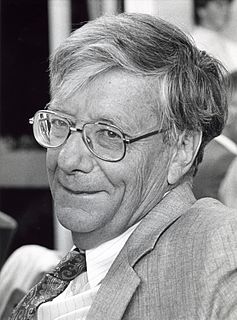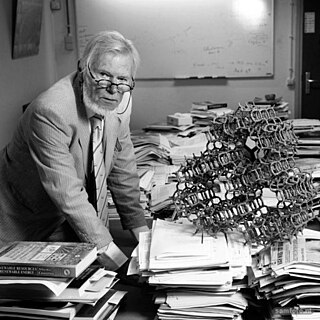Related Research Articles

Jaroslav Heyrovský was a Czech chemist and inventor. Heyrovský was the inventor of the polarographic method, father of the electroanalytical method, and recipient of the Nobel Prize in 1959 for his discovery and development of the polarographic methods of analysis. His main field of work was polarography.

Nicolaas Bloembergen was a Dutch-American physicist and Nobel laureate, recognized for his work in developing driving principles behind nonlinear optics for laser spectroscopy. During his career, he was a professor at Harvard University and later at the University of Arizona and at Leiden University in 1973.

David van Dantzig was a Dutch mathematician, well known for the construction in topology of the dyadic solenoid. He was a member of the Significs Group.

Daan Frenkel is a Dutch computational physicist in the Department of Chemistry at the University of Cambridge.

Allen Joseph Bard is an American chemist. He is the Hackerman-Welch Regents Chair Professor and director of the Center for Electrochemistry at the University of Texas at Austin. Bard is considered a "father of modern electrochemistry" for his innovative work developing the scanning electrochemical microscope, his co-discovery of electrochemiluminescence, his key contributions to photoelectrochemistry of semiconductor electrodes, and co-authoring a seminal textbook.

Martijn Bernard Katan is a Dutch nutritionist, an emeritus professor at the Vrije Universiteit Amsterdam and author of two popular science books on nutrition.
Evert Jan Baerends is a Dutch theoretical chemist. He is an emeritus professor of the Vrije Universiteit Amsterdam. Baerends is known for his development and application of electronic structure calculations, which over time led to the development of the Amsterdam Density Functional. He worked extensively on density functional theory.

Herman van Bekkum was a Dutch organic chemist. He was professor of Catalysis in Organic Chemistry between 1971 and 1998 at Delft University of Technology. He served as rector magnificus of the university between 1975 and 1976. He was an expert in the field of carbohydrate chemistry and zeolites.
George Blasse was a Dutch chemist. He was a professor of solid-state chemistry at Utrecht University for most of his career.
Gerrit"Ger"Challa is a Dutch chemist. He was professor of chemistry and polymer technology at the University of Groningen from 1965 to 1993.

Royce W. Murray is an American chemist and chemistry professor at the University of North Carolina at Chapel Hill. His research interests are focused on electrochemistry, molecular designs, and sensors. He has over 440 publications in analytical, physical, inorganic, and materials chemistry, and has trained 72 Ph.D students, 16 master’s students, and 58 postdoctoral fellows, 45 of whom have gone on to university faculty positions. He was named a fellow of the American Chemical Society in 2012, and holds three patents related to surface-modified electrodes.

Jan Arnold Albert Ketelaar was a Dutch chemist and author of the textbook Chemical Constitution: an Introduction to the Theory of the Chemical Bond. Van Arkel–Ketelaar triangles are named after him.
Robert Wouter Hans Pieter "Rob" Scheller is a Dutch art historian. He was professor of art history, specializing in the Middle Ages, at the University of Amsterdam between 1969 and 1992.
Héctor Daniel Abruña is an American physical chemist whose work focuses on electrochemistry, molecular electronics, fuel cells, batteries, and electrocatalysis. Abruña is director of the Energy Materials Center and Emile M. Chamot professor for chemistry at Cornell University. He became a Fellow of the American Association for the Advancement of Science in 2006, a Member of the American Academy of Arts and Sciences in 2007, and a Member of the National Academy of Sciences in 2018. Abruña conducts research into battery and fuel cell systems using electrochemical techniques and X-ray microscopy and spectroscopy methods.
Joan Henri van der Waals is a Dutch physicist. He was professor of experimental physics at Leiden University between 1967 and 1989. He specialized in molecular physics and clathrate hydrates. One of van der Waal's most significant contributions to the study of hydrates was a series of papers between 1953 and 1958, which eventually culminated in the 1959 publication of his paper on the canonical partition function for clathrates, along with J.C. Platteeuw. To create this partition function, van der Waals made a number of simplifying assumptions, most prominently that neighboring guest gas molecules cannot interact and there is a maximum of one guest per cage.
Joost Manassen was a Dutch-Israeli chemist. He was a professor at the Faculty of Chemistry of the Weizmann Institute of Science.
Albert"Ab"van Kammen is a Dutch molecular biologist and virologist. He was a professor of molecular biology at Wageningen University and Research between 1972 and 1996.
Ferdinand Jacobus van Ingen was a Dutch scholar of Germanistics. He was a professor of German literature at the Vrije Universiteit Amsterdam between 1972 and 1998.
Pieter Dirk"Pim"Jungerius is a Dutch physical geographer. He was a professor of physical geography, climatology and cartography at the University of Amsterdam between 1970 and 1998.
Dirk Jan"Dick"van de Kaa is a Dutch demographer. From 1970 to 1987 he was the first director of the Netherlands Interdisciplinary Demographic Institute. From 1987 to 1995 he was director and rector of the Netherlands Institute for Advanced Study. Van de Kaa was professor of demography at the University of Amsterdam between 1978 and 1998.
References
- 1 2 3 "R. de Levie, 1933 -" (in Dutch). University of Amsterdam. Archived from the original on 30 August 2020.
- ↑ "Robert de Levie". bowdoin.edu. Archived from the original on 24 October 2015.
- ↑ "Robert de Levie". Royal Netherlands Academy of Arts and Sciences. Archived from the original on 26 July 2020.